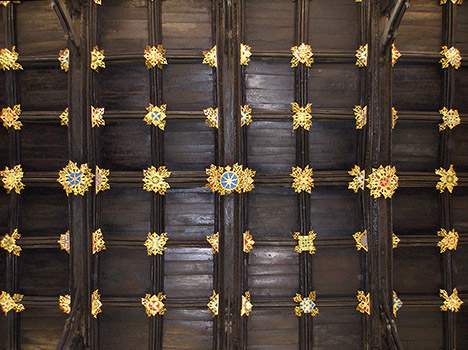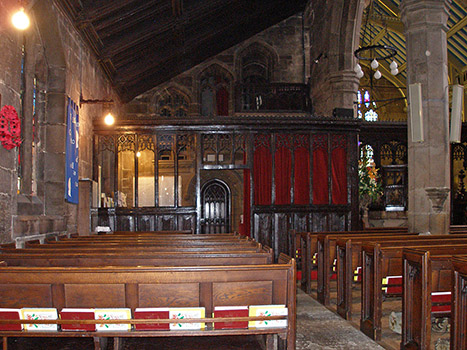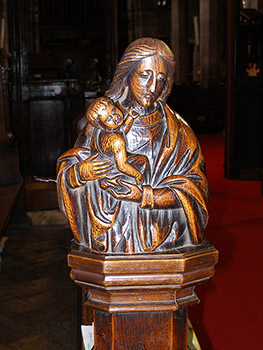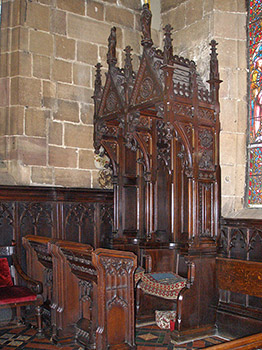 |
| The tower of St. Mary's Cheadle |
 |
| The tower of St. Mary's Cheadle |
 |
 |
|
| The Nave | Ceiling of the nave | |
 |
 |
|
| The Savage Chapel | Entrance to the former rood loft | |
 |
 |
|
| The Brereton Chapel | Alabaster effigies in the Brereton Chapel | |
 |
 |
|
| Figures on a choir stalls | The East Window | |
 |
 |
|
| Wooden Sedilia | Ancient Cross circa 11th century |
The parish church of St. Mary's in Cheadle is not easily photographed from the south side because it is partly obscured by trees, hence I had to be content with two shots of the tower taken from the churchyard. The current church was rebuilt in the middle of the 16th century after an earlier structure fell into disrepair. The north and south arcades have five octagonal columns. The striking oak ceiling of the nave was brought to its current condition by repainting in 1984. The chapel at the east end of the north aisle is the Savage Chapel, built in 1529 by Sir John Savage and his wife Elizabeth. When one looks up inside one can see the entrance to the former rood loft. Rood lofts and screens were commonly destroyed at the Reformation. At the east end of the south aisle is the Brereton Chapel, which houses three effigies. The two alabaster ones are of Richard Bulkeley (1392-1454) and Sir John Hondford (1392- c1460) lord of the manor of Hondford (Handforth). There is also a stone effigy, not shown, of Sir Thomas Brereton of Handforth (1630-1673/4). The screen round the chapel was erected by Sir Urian Brereton.
The screen at Cheadle has a lower part dating from the 16th century whereas the remainder is Victorian. Similarly the pews are from a restoration in the period 1875-1882. The chancel dates from the 1500s but was restored in the 19th century when the roof was replaced in 1859 and the east window replaced in 1861. The church also has a Victorian organ (1882) and a brass lectern in the form of an eagle dating from 1874.
The face of the clock is unusual. Instead of numbers it bears the following inscriptions. On the south side - Forget not God, on the west side Trust the Lord, on the east side Time is Flying. The tower houses eight bells, six of them were made in 1749 and two were donated in 1882. Restoration was undertaken on the tower in the 1985, the lower part is the oldest masonry in the church.
The Parish Church of St. Mary, Cheadle, Cheshire, by G.V. Chivers, a booklet available in the church
The parish of Cheadle was not mentioned in the Domesday Survey of 1086 and may at that time have been waste land. It was granted to Geoffrey son of Hugh de Dutton and the family subsequently adopted the surname of Cheadle/Chedle. The first documentary evidence of the area relates to the enquiry after the death (inquistion post mortem) of Geoffrey's son also called Geoffrey, who died in 1294. The document states the Geoffrey held the manor of Cheadle of the King as Earl of Chester by knight's service, by a rent of one mark known as reynegelt and by finding one judger, once a fortnight, to act at the King's Court in Macclesfield. He also had to contribute to the maintenance of the deer fence in the Forest of Macclesfield and give provisions for sergeants of the peace of the manor of Macclesfield. The manor of Cheadle was said to be worth £20 a year. His heir was named as another Geoffrey then aged 26. This document gives an interesting glimpse of a sparsley populated area on the edge of a hunting forest.
The events that follow explain some place names. Geoffrey was succeeded by Roger de Cheadle, who may have been his brother and who died before 1321 leaving his wife Matilda and two daughters. When Matilda died there was an inquisition post mortem which stated that the manor belonged to the two daughters, nameley Clemence the wife of William de Bagulegh and Agnes wife of Richard de Bulklegh. Thus the de Cheadle family died out and the manor was split into two halves or medieties, subsequently known as townships. The northern half was known as Cheadle Bulkeley and included the church. It came into the hands of Richard Bulkeley, second son of Robert de Bulkeley of Eaton near Davenham in Cheshire.
The southern half went to William de Baguley and his wife Clemence. They had a daughter Isabel, who married Sir Thomas son of Sir Thomas Danyers of Bradley and Appleton in Cheshire. They had one daughter, Margaret who married three times, to John Radcliffe, John Savage and then Piers Legh of Adlington. Margaret Danyers inherited all the lands of her mother, Isabel de Baguley but her father's lands were settled on the male heirs of the Danyers. Margaret survived until 24 June 1427 and there was an inquisition post mortem the following year. This reveals that she had half the manor of Cheadle, the manors of Clifton and Bradley in Appleton, lands at Thelwall, Hale near Bowdon, Lymm, Over Knutsford & Runcorn. She also had a parcel of land at Rainow in the Forest of Macclesfield called Thorneshede, held of the Lady Katherine, Queen of England, as well as four burgages in Stockport and one and a half in Macclesfield. The inquisition papers state that Sir John Savage was her son and heir to these lands and at the time was aged 50 or more. In addition, Margaret had half the manor of Grappenhall during her life which would go to her son Peter, the son of Peter Legh of Adlington. Margaret and her third husband Peter Legh were given Lyme Handley in 1398 as the long-delayed reward promised to her grandfather Sir Thomas Danyers, who had distinguised himself at the Battle of Crécy in 1346.
The Savage family retained this mediety of Cheadle until the Civil War period when the manor was given to Jane Savage, wife of the 5th Marquess of Winchester. He was a Royalist and was fined by Parliament so he sold his share of Cheadle, some time before 1660 to Sir Edward Moseley of Hulme Hall, Manchester. This district became known as Cheadle Moseley and subsequently as Cheadle Hulme. It was sold again in 1754 and then passed through several families in the 18th and 19th century.
The third part of the Parish of Cheadle was Handforth-cum-Bosden. Bosden was a name given to the area of Bullock Smithy, now known as Hazel Grove - just south of Stockport. In the 1230s, the Baron of Stockport granted Bosden to Henry de Honford of Handforth. (Note that in old documents the stems -forth and -ford are often used interchangeably). By the end of the 1200s this family held both Bosden and the manor of Handforth. The family ran out of male heirs in the early 16th century and Margaret Honford married as her second husband, Urian Brereton. The Handforth Breretons ran out of male heirs in 1674. Major General Sir William Brereton of Handforth Hall (1604-1661), was a successful Parliamentary Commander in the Civil War. Lord Byron of Rochdale's Royalist forces were beaten by Brereton and Fairfax at Nantwich in 1641 and this led in due course to Byron surrendering Chester thereby ending Royalist hopes of receiving reinforcements through that port from Ireland. Sir William Brereton and his wife Susan daughter of Sir George Booth of Dunham Massey, had one son, Sir Thomas, born in 1632, who died without issue on 7 January 1673/4 and was buried at Cheadle. Sir Urian Brereton is mentioned in the Brereton family tree on my Malpas page.
So, the history of Cheadle is connected to that of several prominent families in Cheshire. Below I follow the Bulkeley family until they ran out of heirs and, mired in debt, lost the manor of Cheadle in 1756. The story of the Savages is told on the page for Macclesfield St. Michael's, which includes the Savage Chapel.
This family is unusual among the Cheshire gentry. They moved to Anglesey in the early 15th century and in succeeding generations some married into Welsh families and into families based in Lancashire, Derbyshire, Surrey and Essex as well as the Cheshire gentry. Their eventual demise is not related in detail by Earwaker but they were overtaken by debt in the 18th century. The family's Cheshire estates were sold by Act of Parliament in 1756 when the 7th Viscount was only 4. He went on to marry the very wealthy heiress of the Warren family of Poynton but had no issue and left his Welsh estates to his uterine half brother.
On the death of Humphrey Bulkeley, the Cheadle estates descended to his sister, Frances Bulkeley of Cheadle, spinster, and on her death in 1688 they reverted to the Beaumaris branch of the family.
In 1702, Richard Bulkeley, afterwards Viscount Bulkeley, on his marriage to Lady Bridget Bertie, acquired for himself and his male heirs the manors of Cheadle Bulkeley, Timperley and Whatcroft and other lands in these and various places in Cheshire, which had been in the possession of Frances Bulkeley.
In 1731, after the death of Richard Viscount Bulkeley, his eldest son, Richard settled his Cheshire estates in trust to be sold for payment of his debts. An advertisement appeared in the London Gazette of 16 January 1732 announcing the sale of Cheadle, Timperley, Edgeley and Whatcroft and the advowson of the rectory of Cheadle to be held at Cheadle on 5th to 7th March. Richard died in 1738 without male heirs and was succeeded by his brother James. In 1747, the Cheshire Estates were ordered to be sold by a decree in Chancery of 1 March 1745 but the death of James prevented the sale from being completed. In 1756, an Act of Parliament was passed in which the manors and lands in Cheadle, Timperley, Edgeley and Ashley were vested in trustees, Sir William Meredith, Bart., of Henbury, and Robert Williams, Esq. In September of the same year the manor of Cheadle Bulkeley was sold to the Rev. Thomas Egerton, clerk, Rector of Cheadle.
Sources:
East Cheshire Past and Present by J.P. Earwaker, London, 1877 (CRO, Knutsford). Now available from the Family History Society of Cheshire on CD ROM .